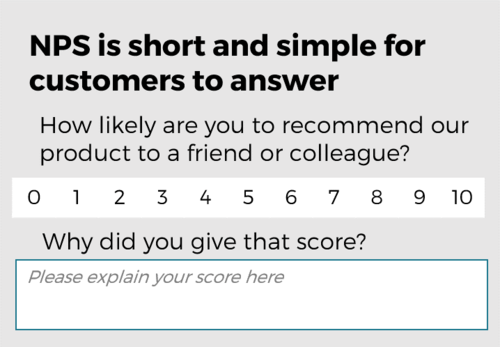4 Reasons Why You Should Use Net Promoter Score

Last updated on August 25, 2022
If our customer is not measuring customer experience yet in any systematic way, we practically always recommend them to start with the Net Promoter Score® (NPS) as the key customer experience metric. But why is that? There are plenty of other possible metrics out there, for instance, the widely adopted CSAT (customer satisfaction) and the nowadays more and more popular CES (customer effort score). Check the full list of the most popular metrics here.
In addition to these widely-used metrics, some companies prefer to use metrics specifically built and tailored for them. Unfortunately, unique metrics easily lead to unique and expensive tools and the impossibility to get any benchmark data without expensive tailored studies. Therefore, the choice of metric needs to be a compromise: it should support your unique business but not at the expense of practicality.
Some companies also feel that they need half a dozen customer experience metrics to really measure the customer experience in detail required. The problem is that, if you have several equally important customer experience metrics, none of them is likely important enough to really drive changes in your business. Complexity is often endorsed by the customer insights function. The rest of the organization would be happier with something simple and actionable.
Finally, there is a group of companies that just choose something that a random survey or rating tool they use happens to support. This can lead to anything and everything: five-star rating, smileys etc.
Why use NPS as your customer experience metric?
1. NPS provides a single, powerful, metric for target setting. It gives that one customer experience related number your leadership needs for target setting and bonuses. Don’t waste time trying to argue for five different meaningful metrics. By adding complexity, you most probably gain very little but lose the simplicity any organization needs to be able to cooperate and really focus on making the improvements needed.

2. NPS is short and simple for the customers to answer. With only two questions (recommendation score and the why-question) you should get most of the insights you need. When more and more people don’t have time or energy to answer any long questionnaires, two questions is a smart way to start.

3. NPS is an industry-standard metric. It is extremely widely used especially in companies that have tied some of the employee compensation to a customer experience metric. The standard nature of NPS ensures that there are benchmarks available. (Although be always careful with benchmarks, as the culture and context of survey impact the absolute level of the metric.)

4. The free text feedback is a great source for insights. If you have read any of my earlier blog posts, you have probably noticed that I consider the free text to be the most important part of NPS. When people are asked, why they gave the score they did, they typically highlight the key things on their minds. Both positive and negative. Analyzing the text helps significantly in understanding the drivers for the current customer experience.
But aren’t there other metrics that fulfill the same criteria?
If you read through my four criteria, you probably noticed that I didn’t say anything specific about the wording of the NPS question (How likely are you to recommend…). Over the years there has been a lot of arguing and controversy over whether that particular question is more powerful than some other question in predicting growth.
Since Frederick Reichheld introduced the metric and claimed it to be the one number you need to grow in 2003, a lot of effort has been put to criticize the wording of the question, the complexity of the score calculation and even the eleven-point scale it uses. Many people have also tried to find a metric with a better predictive power than NPS, but their success has been questionable. (If you are interested in the topic, check for instance this list. It includes studies both for and against NPS.)
I don’t mind. And unless you are a scholar, aiming to find the perfect metric, neither should you. For any company who cares about its customer experience, the key is to just choose a metric that works and stick to it. And by “works” I mean it should fulfill the criteria above: provide a number to follow, include text feedback for insights, enable some level of benchmarking, be simple for customers to respond and simple enough for your employees to understand.
The systematic follow up of the number and actions done based on the insights will bring in the value for you and your customers. The improvements you make driven by the metric are far more important than the metric itself.
